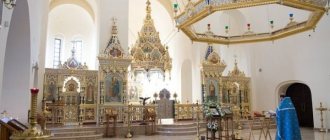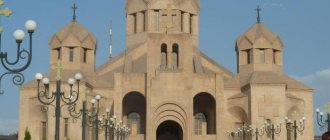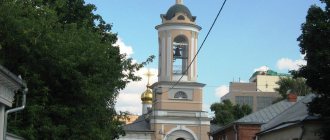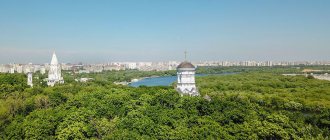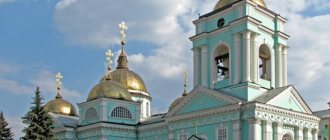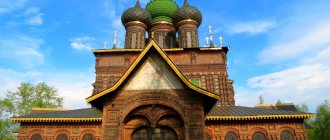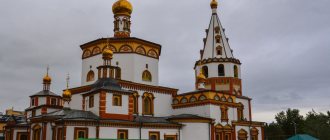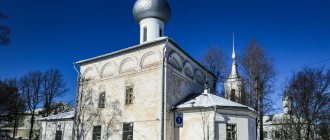In the center of Kerch stands the unusual four-pillar cross-domed Church of St. John the Baptist. It does not fit into the modern surroundings of the city at all. The tall and elegant pink and white temple with a single flat dome on a large drum is so ancient that archaeologists still doubt whether it was built in the 8th or 9th century.
It is only certain that this happened before the Baptism of Rus'. The temple in Kerch is the oldest in Russia. Even Europe can hardly boast of the presence of such an ancient stone shrine, which stood in Crimea for 12 centuries and withstood all the vicissitudes that occurred during this time.
Temple architecture
The Temple of John the Baptist (John the Baptist) is a monument of Byzantine architecture, a museum of ancient history and an active church at the same time. It was built in the best traditions of the Eastern Christian school of architecture in the image and likeness of most ancient churches built in the capital of Byzantium - Constantinople.
The Church of John the Baptist consists of two parts. The first one is ancient. It was built approximately in the 8th century and significantly restored in the 10th century. Large white and thin pink bricks - plinths - were used in construction. They were laid out in rows, due to which the church acquired a white and pink color.
This alternation of plinth and white brick was not used for aesthetic beauty and elegance, as one might assume, but served as a natural strengthening of the Orthodox shrine in case of seismic activity. It was this important nuance that allowed the Church of John the Baptist to survive to this day.
The stone temple is crowned with a flat dome and a cross; the dome is supported by cruciform vaults, which are supported by four pillars. The role of supporting structures is performed by marble columns with elegant Corinthian capitals. Three altar apses adjoin the temple.
The second part of the temple, including a two-tier bell tower in the Russian-Byzantine style, a three-nave vestibule and a northern aisle, was built in the 19th century.
An interesting fact: the northern aisle of the church was consecrated in November 1893 in the name of the Great Martyr Catherine and St. Nicholas the Wonderworker in memory of the miraculous salvation of the heir to the throne, Tsarevich Nicholas, who was assassinated in Japan.
Exactly one year after these events, Nicholas became Emperor Nicholas II, walked the way of the cross prepared for him and accepted the crown of martyrdom in 1918. In 2000, he and his family were canonized and glorified as saints, and in the northern aisle of the Church of John the Baptist a large icon of the holy passion-bearer Tsar Nicholas II and a memorial plaque in his honor appeared.
Interesting facts about the church
Numerous tourists and pilgrims come to the port city of Kerch to see with their own eyes a masterpiece of Byzantine architecture.
It is worth highlighting the following interesting information about the cathedral, which only strengthens the desire to visit the amazing temple:
- The age of the oldest structure is almost one and a half thousand years. Having crossed the threshold of the church, visitors involuntarily leave all earthly worries and plunge into reverent silence;
- restorers and architects managed to preserve the foundation, the northern wall with the original masonry and the cross-domed layout of the structure of the 11th century AD;
- Empty amphorae were mounted into the wall of the temple to enhance the acoustics and convey the words of sermons to every parishioner;
- most of the original fresco paintings were destroyed during the period of Ottoman rule in the Crimea;
- during one of the reconstructions of the cathedral, scientists discovered under a layer of plaster fragments of images of the figures of two saints - it is assumed that the authors of the frescoes were students of the legendary Byzantine artist Theophan the Greek;
- In past times, on solemn religious days, numerous pilgrims flocked to the temple to see a unique relic - a stone with a depression in the shape of a human foot. According to local legends, the footprint was attributed to Andrew the First-Called or the Forerunner of the Lord. Water was poured into the imprint and believers drank it to heal from ailments;
According to the description of the 19th century Crimean historian Kh. Zenkevich, unique Christian relics were kept in the cathedral. Among them:
- gilded oak iconostasis;
- manuscripts of the 11th-12th centuries;
- images of the Mother of God, the Savior, John the Baptist.
Ancient icons were placed in icon cases framed with precious stones. Unfortunately, religious artifacts have not survived to modern days.
John the Baptist, Kerch, history of the temple
Legend has it that the blessing for the construction of the church in Kerch was given by a disciple of Jesus Christ, Andrew the First-Called, who preached in Crimea. And one of the first cities that the apostle visited, spreading the good news of the resurrection of Jesus Christ, was Kerch.
The emergence of the Church of John the Baptist in Crimea is also associated with the name of Simon the Canaanite, the second apostle of Christ, who was one of his twelve disciples. There is a version that the relics of St. Simon were kept in the temple for a short time, but it is difficult to say whether this is true or not.
Today, traces of the stay of Simon the Canaanite and Andrew the First-Called in Crimea are evidenced by a stone slab standing in the courtyard of the church. In its recess there is a footprint, which, according to church tradition, belonged to one of the apostles.
The official date of construction of the temple in Kerch is considered to be 752, that is, the 8th century, although this is only the estimated date of the foundation of the shrine. It was taken as a starting point after archaeologists discovered an inscription on one of the ancient columns stating that in 752 a certain man named George was buried within the walls of the church.
However, the columns themselves are 200 years older than the burial inscription. Archaeologists suggest that the columns could have been taken from an even more ancient church built in Kerch in the 6th century. In the 9th century, this church, according to some researchers, burned down, and in its place the Church of John the Baptist was erected.
This is where doubts about the founding date of the shrine arose: some archaeologists attribute it to the 8th century, and some to the 9th century.
The next mention of the Church of St. John dates back to the 11th century. The Tmutarakan stone, found in the 19th century and kept in the Hermitage, indicates the distance between Kerch and Tmutarakan, which Prince Gleb measured in 1068. Researchers believe that the Church of John the Baptist was taken as the starting point for measuring the distance.
In the Middle Ages, when Crimea was under colonial rule of the Genoese, the Church of St. John was at the peak of its glory. Believing Genoese even called the Kerch Strait after the prophet, and Kerch itself was called the port of John the Baptist, to say nothing of the church of their beloved saint: during these times it experienced its heyday.
A difficult period in the history of the temple began in the 15th century, when the Crimean Khanate was formed in Crimea. The Crimean Tatars did not destroy the Christian temple, but tried to scrape off and paint over all the frescoes and icons that were in it, and then turned the shrine into a mosque.
The Church of John the Baptist regained its status as an Orthodox church only after Crimea became part of the Russian Empire at the end of the 18th century. And already at the beginning of the 19th century, when the ancient part of the temple was being reconstructed, the builders discovered under the dome two frescoes depicting saints, which the Muslims had not completely destroyed.
These frescoes, according to one Soviet restorer, were painted by students of the famous icon painter Theophan the Greek.
What can be seen in the interior of the cathedral
The religious building does not attract with colorful frescoes and luxurious interiors. The Church of St. John the Baptist has a peaceful atmosphere. Here you can feel the special energy of the ancient place of worship and feel the breath of early Christian times.
The vaulted ceiling is supported by four dark gray marble columns with Corinthian style capitals. Between them hangs a massive bronze chandelier. Of interest is a section of pristine porous stone wall without plaster, which allows visitors to touch the thousand-year history.
In the interior decoration of the Christian shrine, you can see floor icon cases decorated with artistic carved elements, wooden frames, columns and semicircular headbands with a cross. The iconostasis is adjacent to one of the walls. The cathedral contains the relics of saints, a wooden bowl with a barely visible image of the Savior, as well as two silver bowls from the 16th-18th centuries.
Church of John the Baptist after the 1917 revolution
After the events that occurred in 1917, the Church of John the Baptist continued to operate. Divine services were still held there every day. The ancient Byzantine temple was closed only in the 30s.
In 1974, reconstruction of the temple began. Restorers restored the partially destroyed white brickwork and plinths and installed a metal frame under the dome of the church to avoid its destruction.
Artists renewed the ancient plaster and painting of the church. The final touch of the reconstruction was the Orthodox cross, which the builders installed on the dome. The Soviet authorities did not give the go-ahead for the erection of the cross, but they no longer began to remove it.
In 1978, a museum was opened in the church, housing objects of ancient art found during excavations in Kerch.
The Church of John the Baptist returned to the fold of the Russian Orthodox Church in the early 1990s. At the same time, the Divine Liturgies were resumed.
Years under the Turks
In 1475, part of the peninsula, including Kerch, was captured by the Ottoman Empire. The next three centuries were very difficult for the Christian population of Crimea. During this time, the Church of St. John the Baptist was converted into a Muslim mosque. The fresco painting that was there originally, and was, according to one version, the creation of the students of Theophanes the Greek, was carefully scraped off the walls.
After the period of Turkish rule, only the image of two saints remained in the temple, which was discovered already in the 19th century under a thick layer of plaster.
In 1774, after the first Russian-Turkish War, a peace treaty was concluded between the two countries. The Crimean lands, according to its terms, gained independence, and 9 years later they were annexed to Russia. Orthodox services began to be held again in the Kerch Church of John the Baptist. Its parishioners were mainly Greeks.
Church of St. John the Baptist, Kerch
Chapel-belfry of the Apostle Andrew the First-Called (Kerch)[edit]
According to legends and early medieval sources, in the 1st century, Christ’s disciple, Apostle Andrew the First-Called, preached Christianity in Kerch during his travels through the country of the Scythians.
In memory of this, on September 13, 2003, a chapel-belfry was consecrated, consisting of two metal columns standing on a granite cylinder, topped with a dome with a cross. The cylinder has a dedication inscription.
Address:
Republic of Crimea, Kerch, st. Komarova, opposite no. 2, pl. Shlagbaumskaya
Church of the Myrrh-Bearing Women (Kerch)[edit]
The building (year of construction before 1917) for the temple was initially transferred, according to the decision of the city session of July 16, 1998, to the balance of the religious Orthodox community of the St. Alexander Nevsky Church, taking into account the petition of the dean of the Kerch district, Archpriest Sergius Koval, dated June 5, 1998. , as well as the appeal of the Orthodox residents of the city.
On March 20, 2003, by decision of the city session, the church building was transferred from the balance of the Orthodox community of St. Alexander Nevsky Church to the balance of the Myrrh-Bearing Women's community.
Since September 25, 2014, the rector of the temple is Priest Valentin Melnik.
Address:
Republic of Crimea, Kerch, st. Voikogo 12
Telephone:
+7 (978) 0569111
Email:
Assumption Church
The Assumption Church is the only functioning Catholic church in the city, located in the central part of Kerch on Teatralnaya Street, 30.
The ancient Roman temple was built in the 19th century by architects following the style of classicism, commissioned by the Italian community.
During Soviet times, the Assumption Church was turned into a gym, and in the 90s it was partially destroyed. After 6 years of restoration, the appearance of the temple pleases parishioners with its white decoration, majestic columns, arches and icons created by Kerch artists.
Tourist information
Every tourist can visit the church on any day of the week; it is open seven days a week. On average, one tour of the temple lasts a minimum of 40 minutes and a maximum of 1.5 hours. A priest is appointed as a tour guide. You can visit this historical place absolutely free.
Schedule of services[edit]
Tuesday
, 8.00 - hours, liturgy, confession, communion
17.00 - evening service
Wednesday
, 8.0 - hours, liturgy, confession, communion
17.00-evening service
Thursday
, 8.00 - hours, liturgy, confession, communion
17.00 - evening service
Friday
— 8.00 o’clock, liturgy, confession, communion
17.00 - evening service
Saturday
— 8.00 — hours, liturgy, confession, communion
10.00 - baptism
17.00 — all-night vigil
Resurrection
— 7.00 — hours, 7.30 — early liturgy
9.30 - hours, 10.00 - late liturgy
At the end of the liturgy, there is a prayer service on all days.
At the end of the prayer service there is a memorial service.
During the winter period, evening services begin at 16.00.


